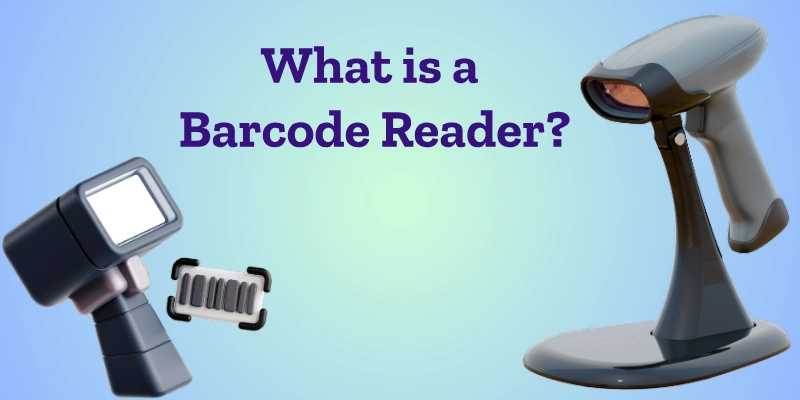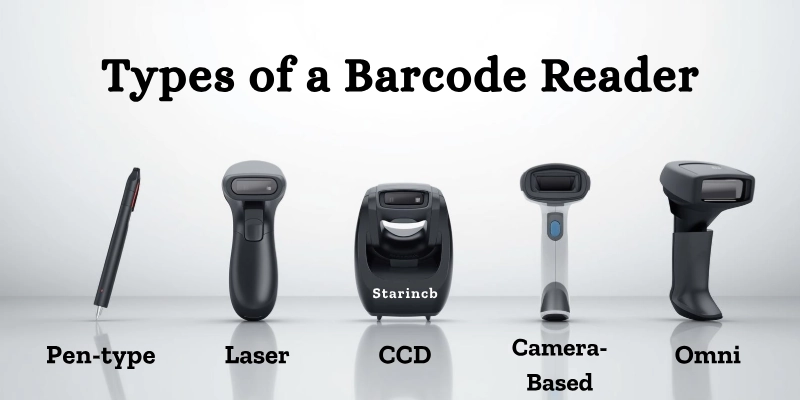What is a Barcode Reader? See How It Simplifies Work
Published: 26 Oct 2025
Have you ever noticed those black-and-white lines on product packs that get scanned at billing counters? That’s where a bar code reader does its magic!
It is a device that quickly captures information like product name and price from barcodes and sends it to the computer for easy processing. It makes work faster, reduces human error, and is used almost everywhere, from shops to hospitals.
In this article, you’ll learn what is barcode reader, barcode reader meaning, how it works, its types, and the uses of barcode readers in daily life.
What Is a Bar Code Reader?
A bar code reader (or barcode scanner) is a computer input device used to read printed barcodes and send that data to a computer. It helps identify products quickly and accurately by scanning the barcode and converting it into digital information.

Every product has a barcode, a set of black and white lines that represent numbers or letters. A barcode reader uses a light beam or laser to scan these lines. The reader then translates the pattern into numbers or text that the computer understands. This process is fast, simple, and avoids the need for manual typing.
In short, the bar code reader acts like a bridge between the product and the computer, helping the system know what the product is, its price, and other details in just a few seconds.
Example:
When you buy something at a supermarket, the cashier scans the barcode on the product. Instantly, the price and item name appear on the computer screen.
That’s the barcode reader at work; it reads the barcode, sends the data to the computer, and helps complete the billing quickly and accurately.
How Does a Bar Code Reader Work?
Have you ever wondered how a barcode reader reads those lines so fast? It works through a simple process that involves light, reflection, and data conversion.
Let’s understand it step by step with a clear flow:
Input → Processing → Output
- Scanning:
The barcode reader shines a beam of light (usually a laser) onto the barcode printed on a product. - Reflection:
The light reflects back differently from the black and white bars; black absorbs light while white reflects it. - Detection:
A sensor inside the reader detects this pattern of reflected light. - Conversion:
The reader converts the light pattern into electrical signals, which are then changed into digital data (numbers and letters). - Transmission:
Finally, this digital data is sent to the computer, where the system processes it and identifies the product details like name and price.
Example:
When you buy something from a store, the process goes like this:
- The cashier scans the barcode using a barcode reader.
- The reader captures and converts the barcode into a product code.
- The computer system reads this code and instantly displays the product name and price on the screen.
That’s how a barcode reader works: fast, accurate, and simple!
Parts of a Bar Code Reader
A bar code reader is made up of several important parts that work together to read and send data from barcodes. Each part has a special job that helps in scanning and processing information smoothly.
Here’s a simple table showing the main parts of a barcode reader and their functions:
| Part Name | Function |
| Light Source | Shines light on the barcode so it can be read. |
| Lens | Captures the light reflected from the barcode. |
| Sensor | Detects the reflected light and converts it into electrical signals. |
| Decoder | Changes the signals into readable data (numbers or text). |
| Cable/Wireless Transmitter | Sends the decoded data to the computer system. |
These components of a barcode reader work together to quickly and accurately scan barcodes on products.
Types of Bar Code Readers
Bar code readers come in different types based on their technology, range, and usage. Each type has its own benefits and is used in different places, from small shops to large supermarkets.

Here are some types of barcode readers.
- Pen-type barcode reader
- Laser barcode reader
- CCD barcode reader
- Camera-based barcode reader
- Omni barcode reader
Let’s talk about them.
Pen-Type Barcode Reader
A pen-type bar code reader looks like a pen and is used by manually moving it across the barcode. It is small, cheap, and simple to carry, but it requires some skill to use correctly. These are commonly found in small shops or inventory setups where space is limited.
Laser Bar Code Reader
A laser bar code reader uses a laser beam to scan barcodes. It can read from a distance, making it faster and more convenient. These readers are highly accurate and are widely used in stores, warehouses, and industries for quick product scanning.
CCD (Charge Coupled Device) Bar Code Reader
The CCD bar code reader uses light sensors to capture barcodes from a close distance. It does not have moving parts, making it durable and long-lasting. You’ll mostly see CCD readers used at retail counters and point-of-sale (POS) systems.
Camera-Based or Imaging Bar Code Reader
A camera-based bar code reader uses a digital camera and image sensors to capture and decode barcodes. It can read both printed barcodes and digital ones displayed on screens (like phones or tablets). These are often used in smartphones, tablets, and modern checkout systems.
Omni-Directional Bar Code Reader
An omnidirectional bar code reader can scan barcodes from any angle using multiple laser beams. It provides fast scanning and is commonly used in supermarkets and shopping malls for quick billing.
| Type | Technology Used | Range | Common Use |
| Pen-Type | LED light | Very close | Small shops |
| Laser | Laser beam | Medium | Supermarkets |
| CCD | Light sensors | Close | Retail counters |
| Camera-Based | Image sensor | Medium | Smartphones |
| Omni-Directional | Multi-laser | Long | Shopping malls |
Each of these types of barcode readers has unique features that suit different needs, from simple billing to advanced industrial scanning.
Uses of Bar Code Reader
Bar code readers are used in many places to make work faster and more accurately. They help record and manage information quickly without mistakes.
- Shopping Malls and Supermarkets:
Used at billing counters to scan product details instantly. It makes checkout faster and reduces typing errors. - Libraries:
Helps in issuing and returning books easily. Keeps track of borrowed and available books without confusion. - Hospitals:
Used for patient identification and medicine tracking. It ensures the right medicine reaches the right patient. - Offices and Inventory Systems:
Used to track goods, files, and assets quickly. Helps manage stock and office records accurately. - Transportation:
Used for tracking parcels and tickets during travel or delivery. Makes the delivery process faster and reliable.
Advantages and Disadvantages of a Barcode Reader
Barcode readers make work easier and faster, but they also have some limits. Here’s a simple look at both sides:
| Advantages | Disadvantages |
| Fast and accurate | Can’t read torn or damaged barcodes |
| Reduces errors | Needs proper light and a clean barcode to scan |
| Easy to use | Can be costly for small businesses |
| Saves time | Works only within a limited range |
| Improves work speed | Requires technical maintenance sometimes |
Barcode readers are very helpful in daily work, but keeping them clean and well-maintained ensures they perform their best.
Bar Code Reader vs QR Code Reader
Both bar code readers and QR code readers are used for scanning, but they work with different types of codes and store different amounts of data.
Here’s a simple comparison:
| Feature | Bar Code Reader | QR Code Reader |
| Code Type | Linear (1D), series of vertical lines | Square (2D), pattern of black and white boxes |
| Data Capacity | Limited stores fewer characters | High, can store text, links, and payment info |
| Reading Device | Uses a laser or CCD sensor | Uses a camera or image sensor |
| Usage | Common in product labeling and billing | Used in websites, apps, and digital payments |
| Example | Grocery store scanner | Mobile phone QR code scanner |
A bar code reader is used for basic product scanning, while a QR code reader is used for advanced digital uses like payments and web links.
Importance of the Bar Code Reader
A barcode reader plays an important role in modern technology and business. It helps save time, reduce mistakes, and make work easier in many fields.
It helps businesses work faster and more accurately, especially during billing and inventory tasks. Scanning barcodes instead of typing details saves time and reduces human errors.
Bar code readers also make data storage and tracking simple and organized. They are now used in education, business, hospitals, transportation, and many other areas where quick and accurate data handling is needed.
Examples of Bar Code Readers
Bar code readers come in different forms, each designed for specific uses. Here are some common examples of barcode readers and where they are used:
| Example | Use |
| Handheld Scanner | Used in shops and malls for scanning product barcodes at billing counters. |
| Wireless Scanner | Used in warehouses to scan products or boxes from a distance without cables. |
| Mobile Phone Camera | Used in smartphones for scanning QR codes and barcodes in apps and websites. |
| Desktop Scanner | Used in retail billing systems for quick and hands-free product scanning. |
These types and examples of barcode readers show how widely they are used in different fields to make data handling faster and easier.
Barcode Reader in a Computer System
A barcode reader acts as an input device that sends scanned data directly to the computer system. It reads the barcode, converts it into digital information, and transfers it to the computer instantly.
It helps in data entry automation, reducing manual typing and human errors. Bar code readers are also a key part of POS (Point of Sale) systems used in retail stores for quick and accurate billing.
In a computer setup, it works just like other input devices and connects with various computer hardware components to make operations smoother.
Conclusion
A bar code reader is a smart input device that reads barcodes and sends the data to a computer instantly. It helps in quick and accurate data entry, making work smooth and error-free.
The main benefits of a bar code reader are its speed, accuracy, and ease of use. It saves time, reduces mistakes, and improves efficiency in every field.
From small shops to big industries, the bar code reader helps make our digital world faster and smarter.
FAQs
Check out these FAQs about barcode readers to clear your doubts and learn more in simple words!
A bar code is used to store product information in the form of lines and numbers. It helps in the quick identification and billing of items.
A BCR (Bar Code Reader) sends scanned data directly to the computer. It helps in fast data entry and reduces manual errors.
Simply point the scanner at the barcode and press the scan button. The data will appear on the connected computer screen.
Businesses, shops, hospitals, and libraries use BCRs for quick data handling. It’s useful wherever items need to be tracked or recorded.
Yes, modern barcode readers and smartphone apps can scan barcodes from screens. They use light sensors or cameras to read digital images.
BCRs are used in malls, offices, warehouses, and transport systems. They help in billing, tracking, and inventory control.
It shines light on the barcode and detects the reflected pattern. The data is then converted into digital form and sent to the computer.

- Be Respectful
- Stay Relevant
- Stay Positive
- True Feedback
- Encourage Discussion
- Avoid Spamming
- No Fake News
- Don't Copy-Paste
- No Personal Attacks

- Be Respectful
- Stay Relevant
- Stay Positive
- True Feedback
- Encourage Discussion
- Avoid Spamming
- No Fake News
- Don't Copy-Paste
- No Personal Attacks





